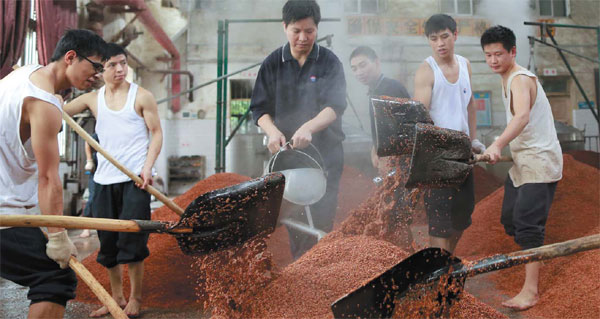Turning red into gold
Building on advantages the local environment provides, a Moutai production supervisor maintains exacting standards from the ground up, reports.
For master brewer Zhao Chanhuai, the color red plays a central role in his work at the heart of Moutai's production facility.
The national liquor is distilled from fermented red sorghum, a distinctive variety specially cultivated in Guizhou province.
"The variety more widely grown in the north of the country is not suitable. The quality is different and the resulting taste will simply not be the same," Zhao said.
The Chishui River running through Maotai town means Red Water River. With ideal mineral content, it is the sole source of water for making Moutai.
An annual natural phenomenon paints the waterway reddish-brown from the silt of the rainy season - early summer to late autumn - before turning back crystal clear for the rest of the year.
In October, Zhao's work begins in earnest. His team of 13 armed with shovels first mix brewer's yeast of crushed wheat grain into red mounds of broken sorghum grain, piled more than a meter high on the facility's moist stone floors.
"The red sorghum we use is actually from the harvest of the previous year. The grain is kept for a year to assess its quality," Zhao said.
"We then start the process by breaking up and moistening the sorghum, mixing in the yeast. This is done by hand and with experience in line with tradition. It's an all-natural process."
The multi-layered fermentation and distillation processes that follow involves repeated boiling, steaming and packing the mash in 12 storage vats, which help fuel the rich buttery aroma that permeates the air in the production halls.
A complete production year includes guiding the sorghum through at least eight cycles of fermentation and monitoring it through nine stages of distillation under carefully controlled conditions.
Zhao, 39, has been working for Moutai for 15 years. His team members, all men, have at least five years of brewing and distillation experience. Veterans within the team like Zhao help mentor younger colleagues in their late 20s along the process. All are "constantly learning" about the time-honored methods of making Moutai, he said.
His team's 12 cellars yield more than 70 tons of base liquor a year. That is subsequently handed over to other colleagues down the production line who classify the stock into three main categories for Moutai's various alcoholic products. About 20 percent of the produce from Zhao's team makes it to the "sauce-scented" first grade every year.
Zhao's compensation is linked to the amount of top-quality liquor he produces. More of his work sold under the much-coveted Flying Moutai flagship range means bigger year-end bonuses for him and precious travel opportunities.
But that is easier said than done. The town's environment offers a delicate and complex convergence of climate, ingredients and other factors that Zhao must consider to ensure quality is maintained throughout.
"Quality is my biggest concern. Meeting the high standards of Moutai consistently is our top priority and that can only be done by keeping close tabs on the whole process.
"That starts from the very first shovel of sorghum and drop of Chishui River water," said Zhao.
"It's not just the amount of quality liquor that we make. If any of the liquor from our vats don't pass muster, it affects our team's reputation and morale since we are also competing with other units," Zhao said.
Zhao's keen awareness of the importance of a unique quality derived from the local environment is reflected throughout the company.
'Ultimate enjoyment'
The head of the company, Yuan Renguo, writes in his book Maotai: The Ultimate Enjoyment that the ingredients that workers like Zhao handle "absorbs the seasonal essence and aura of heaven and earth".
"In the relatively long brewing process, the microorganisms fully activate and impurities are gradually eliminated."
The liquor produced then needs to be carefully blended, classified and preserved in climate-control rooms. At least five years pass before the product hits the shelves.
About 1 kilogram of liquor is made from every 5 kg of red sorghum. That is about 3 kg more grain going into each bottle of Moutai than what the average domestic Chinese liquor producer churns out. The higher concentration of sorghum helps translate into the fully rounded flavor of Moutai that allures so many drinkers.
More than a decade ago, Moutai had also realized the importance of protecting its material base. It built a state-of-the-art sorghum production center in 2000 and subsequently invested nearly 100 million yuan ($16.3 million) into the facility.
The Ministry of Environmental Protection has also identified Moutai's centers as "organic raw material bases", which the International Federation of Organic Agriculture Movements as well as many certification agencies in Canada and the European Union also later recognized.
Zhao feels the high quality of red sorghum directly, with the batches of liquor his team makes from April to June producing the best results.
"The 'golden period' during these three months can be very hot and humid. It is the toughest time for us but that is also when the fermentation process is optimal," he said.
For the team leader, the work is all worthwhile - especially when he finds out that a lot of the quality liquor he makes has found its way into the white Flying Moutai bottles, immediately recognizable with their bright-red labels.
"Everyone knows Moutai's red-labeled bottles," Zhao said.
"That color is our source of pride."
|
Master brewer Zhao Chanhuai (central) and his team members mix yeast into sorghurm prior to the fermentation process. Feng Yongbin / China Daily |
(China Daily 03/09/2015 page7)















